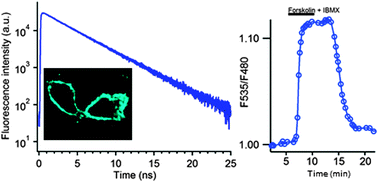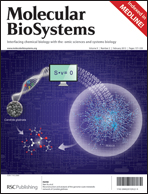Minimum set of mutations needed to optimize cyan fluorescent proteins for live cell imaging†
Abstract
Cyan fluorescent proteins (CFPs) are widely used as FRET donors in genetically encoded biosensors for live cell imaging. Recently, cyan variants with greatly improved fluorescence quantum yields have been developed by large scale random mutagenesis. We show that the introduction of only two mutations, T65S and H148G, is able to confer equivalent performances on the popular form ECFP, leading to Aquamarine (QY = 0.89, τf = 4.12 ns). Besides an impressive pH stability (pK1/2 = 3.3), Aquamarine shows a very low general sensitivity to its environment, and undetectable photoswitching reactions. Aquamarine gives efficient and bright expression in different mammalian cell systems, with a long and single exponential intracellular fluorescence lifetime mostly insensitive to the fusion or the subcellular location of the protein. Aquamarine was also able to advantageously replace the CFP donor in the FRET biosensor AKAR for ratiometric measurements of protein kinase A activity. The performances of Aquamarine show that only two rounds of straightforward single point mutagenesis can be a quick and efficient way to optimize the donor properties in FRET-based biosensors.


 Please wait while we load your content...
Please wait while we load your content...